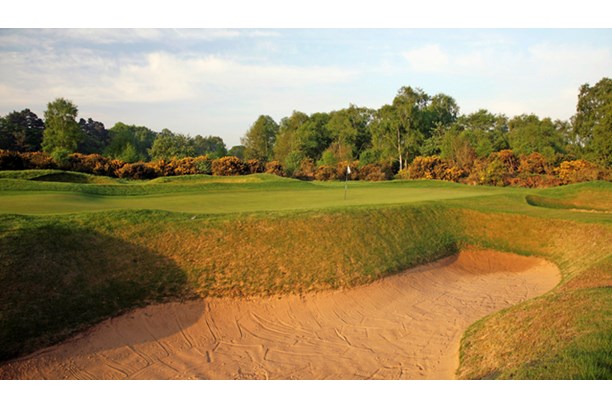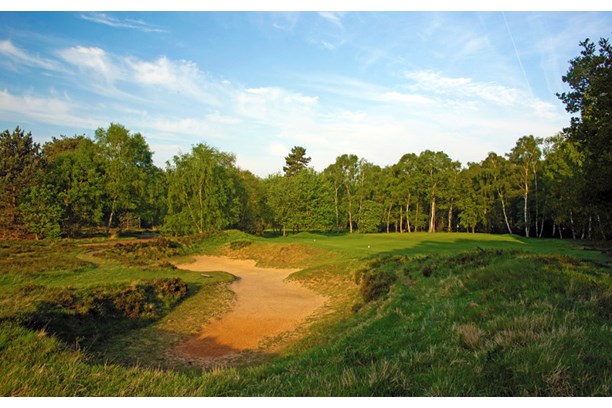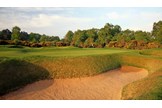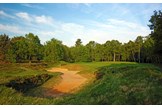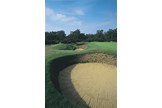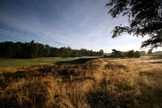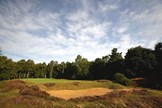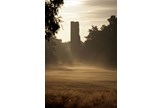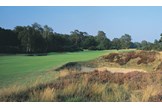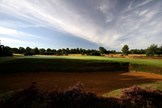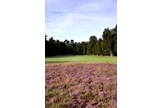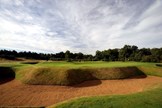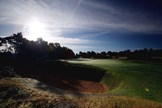Woodhall Spa Golf Club (Hotchkin Course)
Last updated:
What we say
Woodhall Spa Golf Club’s Hotchkin Course has undergone a huge Tom Doak renovation that has seen its status as one of the world’s best golf courses return. Golf World Top 100 editor Chris Bertram explains what makes the Lincolnshire heathland so special.
According to the folks who measure these things, the UK has only 20-25 percent of the heathland it possessed in 1800, and the number-one reason for this startling decline is encroaching flora.
Once trees get their roots into the sandy subsoils that typically support lowland heath, the very nature of the land changes. The heather, lichens and gorse stop growing and its delicate ecosystem, so valued in supporting threatened species like adders and nightjars, begins to break down. Heathland reverts back to its original, ancient woodland state… and remarkably quickly.
All this may not have been at the top of Harry Colt’s thoughts when he called trees “a fluky and obnoxious form of hazard”, but it certainly was at the forefront of discussions when Woodhall Spa got together in 2014 to discuss making improvements to its epic Hotchkin course.
“Aerial photographs taken in the 1960s clearly show that apart from plantations around the edge of the site, there wasn’t a tree to be seen on this golf course,” says the club’s general manager Richard Latham. “It was pure, raw, open heathland. But after 50 years of what one architect described as ‘benign neglect’, this course had changed. On many fairways golfers were hitting through narrow, forested corridors. Hazards were becoming lost as the trees began to colonise the site, and the challenge was becoming compromised. You know your golf course is not playing correctly when you’re standing on a tee and picking a line around trees that were not there in its original design.”
Also ringing in Latham’s ears were the regular Maydays of Natural England, who had awarded this precious heathland Site of Special Scientific Interest status. Twenty feet deep in places, Woodhall Spa’s rich sand seam was dumped here by glaciers receding at the end of the last ice age, and is an anomaly in a county of boulder clay.
“They were constantly telling us we were going to lose it all,” he recalls.
Such considerations formed the basis for a genuinely gutsy decision by the club to fell upwards of 10,000 magnificent oaks, pines and silver birch as part of a three-year, three-phase plan to give the course back its rightful landscape, its original character and a world ranking worthy of this special site and layout.
“I adore trees,” Latham adds. “While the work was going on I would walk over the course to my office with tears in my eyes. But I have never doubted the correctness of our decision… and now the process has ended, we are seeing the value of it.”
Woodhall Spa Golf Club’s rise and fall
The proud if somewhat remote home of governing body England Golf since 1995, Woodhall Spa has witnessed golf since 1890. Its early nine-holers, no longer in existence, brought the game to the attention of local landowner Stafford Vere Hotchkin; and after seeing those early courses shunted around to make room for an expanding town, he offered to site a third course – this time 18 holes – on his own land. Designed by Harry Vardon, it opened in 1905.
This was, though, a precarious time to be building golf courses. Just three years earlier, the rubber-cored Haskell ball had added 25 yards to drives overnight, though Vardon himself hung on to the obsolete ‘gutty’ longer than most. Further, fresh ideas on ‘strategic’ design – pioneered by a new breed of architecture specialists like Harry Colt and Alister MacKenzie – were superseding the ‘penal’ styles of the professional old guard, whose hazards were positioned to catch tops and wides. So just six years later, Colt himself was brought in to update the course. While the specifics of what he altered remain elusive, contemporary reports suggest he changed the routing, added greenside mounding and undulation, repositioned bunkers to create a more versatile, tactical test and increased the overall yardage. These works formed the basis of the course we see today.
That said, Hotchkin himself took over the running of the club in 1919 after it ran into post-war financial difficulties. This gave him licence to tinker with the course if he saw fit – which, as a keen student of golf course architecture, he frequently did.
“That’s OK if you know what you are doing,” Latham continues. “Fortunately, Stafford did. He believed a course should conform to its natural surroundings, and had a keen eye both for strategy and aesthetics. Indeed there is plenty of evidence to suggest he improved Colt’s layout over the years; he took the 3rd green 30 yards back and sited it on top of a plateau to create a stunning level site; he built up the 4th green too, developing an impressive complex. He made the challenge more interesting, and more intense.”
It was, however, another of Hotchkin’s design tenets – that bunkers should be bold where possible – that would ultimately create problems for his beloved course.
“Just before Stafford died in 1953, he handed control of the club to his son, Neil,” says Latham. “It seems possible that Neil, in trying to stay faithful to the ideals of his father, interpreted ‘bold’ as ‘deep’. Stafford’s bunkers were sizeable but not especially deep, but in more recent years they got deeper and deeper. The bunker to the left of the par-3 12th got to 12ft deep, and several others weren’t far behind; in fact one bunker on the 4th managed to snare a Hillman Imp in the 1970s. If you make a bunker deeper, you have to rework the landscaping around it to get the right falls, and this wasn’t done as well as it could have been. We ended up with some very narrow zones at the bottom, and you had to be extraordinarily skilled to get the ball up and out.”
The club began to experience issues with collapsing bunker banks. The increasing amount of shade created by the trees was affecting growth, and playing surface quality. Against the backdrop of a steadily falling world ranking, the club began to realise that despite the sustained popularity of the course, it was papering over cracks. The time had come for bold and decisive action.
The Tom Doak effect
If you want to make a golf course more challenging, do you make its greens bigger or smaller? The correct answer is, believe it or not, the former. ‘Bigger greens’ was one of Tom Doak’s key recommendations for the Hotchkin, after Woodhall Spa chose the leading American architect to execute a three-year, three phase improvement program.
Now a total of 4,000sqm larger, they take the greenstaff an extra two hours to mow every morning. But they also offer a raft of new, tucked pin positions that fire more value and variety into the ideal line in, protect par against the modern power game and ultimately ask more searching questions of the approaching golfer.
Doak was a wise choice. Though perhaps best known for original creations at Bandon Dunes, Streamsong and Cape Kidnappers, he has proved himself a skilled and sensitive course reworker. Royal Melbourne, Pasatiempo and Cherry Hills are among the prized venues that have benefited from his touch.
A minimalist at heart, Doak’s gift lies in exploiting the natural landscape to unlock interesting options for the golfer, whether safe or seductive. His approach was the perfect fit for Woodhall Spa’s Janus-like vision of a modern challenge, intensified and future-proofed, played out across a landscape returned to its raw, rustic heathland origins. Even better was the fact Doak employs perhaps the most skilful landshaping team in the business, something the Hotchkin’s misshapen, abysmal sand traps badly needed.
Instinctively resolved to offer the golfer options, Doak immediately grasped the problem with the trees. “As they encroached, it became increasingly important to play straight shots, rather than concentrating on the angle of attack,” he said in 2016, as the project was getting underway. “There used to be more strategy here, the angle of the second shot was more important, and we are trying to get some of that back. The removal of trees and scrub will not only open up the course but also put a renewed emphasis on strategy for the players.”
“The perfect example of what Tom Doak did to the course was at the 7th,” says Latham. “This is a tough par 4 of some 440 yards, dog-legging right around trees, bunkers and heather. Tom wanted to take out the trees on the right. I thought it would just make the hole easier. ‘Where do you drive it here?’ he asked.
“Everyone hits it up the left because in truth it’s the only option. ‘Well,’ said Tom, ‘If we take those trees out it will encourage golfers to try to cut the corner.’ It was an inspired idea that delivered a tee shot option while bringing the bunkers and heather up the right into play. So far from making the hole easier, it has made it harder. It normally plays the 5th or 6th hardest in relation to par, but at the recent Brabazon Trophy it was second-hardest.”
Doak performed a similar trick on the short par-4 10th, taking trees out to encourage golfers to go for the green. The intense tree-felling allowed him to widen fairways, creating more approach shot angles and allowing him to reinstate many of Hotchkin’s original, lost traps.
Many bunkers have been shallowed, their surrounds remodelled and given a rustic, ragged-edged makeover. Alongside the heather, they remain the course’s chief defence; you will still find yourself looking at the face in the deeper ones and their number has risen from 113 to 142, though their often-fragmented nature makes the total somewhat irrelevant.
But while you will enjoy the extra strategy and choices of Doak’s reworked Hotchkin, you will probably not be so keen on the reduced perspective. For the most part, Woodhall Spa’s greens are simply laid on the ground and are not tilted up to help the golfer. Doak wanted to exploit that not just by creating a greater variety of approach angles, but also by dissolving the assistance with depth perception and distance control given by the surrounding flora.
Many greens here – the 4th, 6th, 7th and 12th especially – were framed by gorse; they’re not anymore. Putting doubt into the golfer’s mind, this subtle work is a neat way of protecting the hole… and a far more pleasing one than simply tacking on 20 yards.
Indeed, within all his amendments Doak has achieved an overall drop in total yardage, from 7,087 yards to 7,042. His work on the Hotchkin drums home just how thoughtless adding yards can be as a method of course protection. After all, when you are adept at using weapons like angles and depth perception, green shapes and awkward pins, you just don’t need it.
Future-proofing the Hotchkin
Five-time host of England’s premier open amateur strokeplay event, the Brabazon Trophy, the Hotchkin has a long list of heavyweight admirers – including Tom Weiskopf and Tony Jacklin who, after an exhibition match back in 1971, proposed it as Britain’s first inland Open venue.
Before Doak’s revision it was good. Great even. But there is no question though that the course has now evolved into something different. Something better. The vast open spaces up the left of the 15th and 16th holes – where before mighty oaks and pines stood – characterise the club’s determination not just to hang on to its prized heathland setting, but to capitalise on it.
While playing surface conditioning remains first rate, the playing experience is more rugged, more raw, with the more expansive bunkers at times resembling sandy waste areas. This vision, coupled with Doak’s strategic flourishes, has surely protected both the course’s appearance, its setting and its challenge for years to come.
We ranked the course No.4 in England in 2020 and in a wider sense, No.23 in our 2020 World Top 100. Woodhall’s bold and astute decision has already borne fruit.
-
Course Summary
- Costs
- TG Rating
- Players Rating
- Address The National Golf Centre, The Broadway, WOODHALL SPA
- Tel 01526 352511
- Website www.woodhallspagolf.com
Course Information
| Course | 71 par |
| Course Style | - |
| Green Fees | £75 |
| Course Length | 6,501 yards (5,945 metres) |
| Holes | 18 |
| Difficulty | Hard 0-10 |
| Course Membership | Proprietary |
Course Features
- Course has: Bar
- Course does not have: Buggy Hire
- Course has: Driving Range
- Course does not have: Practice Green
- Course has: Pro Shop
- Course has: Restaurant
- Course has: Trolley Hire
- Course does not have: Dress Code
- Course does not have: Club Hire
- Course has: Handicap
Your Reviews
-
Proper Golf
The Hotchkin Course is a true golfing delight. Whilst not a hugely long course, it demands both accuracy and sound course management. Deep bunkers are awaiting errand tee-shots and almost all will result in a penalty stroke. The greens are fast and true. My favorite holes were 11,12 and 13. The Bracken course is certainly worth playing also, were it not in the shadow of the Hotchkin I’m certain it would be in the top courses in the county. The clubhouse facilities are great and the staff warm and friendly. This is a must visit.
-
class... sheer class
The Hotchkin is one of the best courses in the UK... FACT! It's always in great nick and the greens are fast and true. But off the normal tees it's not so long but you have to be straight and accurate. the clubhouse is spot on and the practice facilities are awesome. also if you play as an affiliate of the efgu it doen't cost too much either... this really is a must-visit!
-
Great Course and well worth visit!
I played both the Bracken and Hotchkin on my visit. Firstly I must say that Bracken course is not one to be ignored. For a second course it is very good and in fact I scored less well on it than on the Hotchkin (partly to do with lack of a warm up though!). It weaves between trees and provides some challenging holes in places like the 4th, 8th, 14th, 16th (possibly the hardest par three I played as the green is very narrow and when I played it, it was into a 3 club wind!). However the main course the Hotchkin is a delight. Quite narrow and plenty of sand (however fortunately I did not encounter much.) There are no weak holes on the course as the deep heather and sand provides plenty of challenge. Although sometimes said to be flat as a pancake the greens were actually very deceptive and only a handful of putts were holed in our fourball throughout the round (although putting is my worse aspect of my game the others weren't bad!). However despite the courses many awards and claims to brilliance for me it did actually lack that little spark. No doubt it is a fantastic course and the weather was a bit dull, but it didn't get my heart racing… it is quite hard to put but I hope I am getting my point across! One minor critisism is that the welcome although also fine seemed a bit robotic and cold however bar staff were fantastic! But as I payed £35 in June for both courses (on a junior rate) I cannot complain a single bit (even though I have!!!)
-
A real test
Just played both the Hotchkin and Bracken with woodhall's winter package and was the best £125 I've ever spent. The Hotchkin is right up with the best of tem and deservedly so the bunkers should be called bomb craters there so deep, especially the 4th. Will definately be back in the summer to see the course in full bloom.Make the journey you will not be disappointed
-
Take your sand wedge !!!!!!!
when we first arrived we were givivng a warm welcome and were given all of the information needed. The round of golf was most enjoyable due to the fact of the condition of the course. The amount of bunkers is amazing but offers a real test to all handicaps. The course is well layed out and offers a great test of course manegment. Ths course is by far one of the greatest courses withn the british isles !!!.
-
MGB 2007 battle the bunkers, heather and more!
On our recent trip to the home of english golf a great day was nearly spoiled firstly by our collective inability to stay out of the considerable trouble but more importantly the warm beer and attitude of club house staff. It is however a great course - rewarding good golf and punishing the hack! Will go back and hopefully bbe able to finish with a cold beer
-
Stay out of the Sand-or have a sense of homour
The fairways had suffered from our recent dry spell, and the bunkers had a large number of stones- due to the sub soil. Dont let this put you off though, it is an excellent test of golf, and an enjoyable experience, if you don't encounter too many bunkers!!!!!! I did however, find the Bracken course harder-due to the rough being up, and enjoyed it more than the Hotckin- may have been something to do with they way I played though!
-
GOOD
Brilliant course that cou;d not be faulted. Nice big bunkers and nice quick greens. If you want a challenge it is a good place to come. But you should be aware you need to be a good bunker player.
